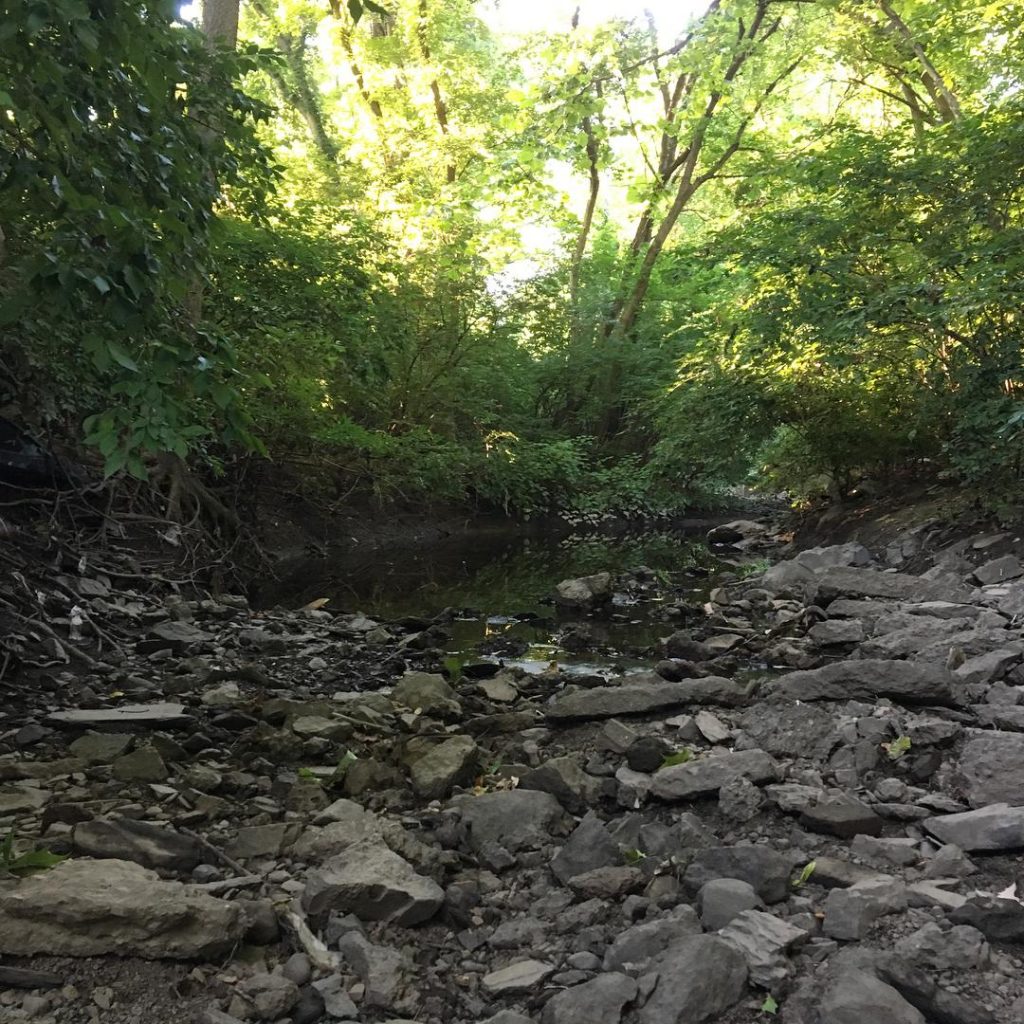“Sinkholes, along with caves, are a definitive part of Pennsylvania’s landscape known as karst,” according to the Pennsylvania Department of Conservation and Natural Resources. “The chemical and physical processes that helped to form this unique landscape have taken place over hundreds of millions of years.”
The top photograph shows the Plymouth Creek, roughly 300 feet north (upstream) of where Plymouth Creek passes under Elm Street in Connaughtown, according to Mr. Ed Pluciennik, a landscape painter. “The location is adjacent to the Cross County Trail, but not clearly visible due to the thick vegetation,” explained Mr. Pluciennik. “When hiking the streambed, it’s fairly obvious, as the bed is dry with almost no water until you reach this spot, at which point a pool/pond is clearly there. At its outflow, it flows between and under some rocks and disappears underground into the sinkhole.”
This sinkhole in the Plymouth Creek is typical of many sinkholes in the Freedom Valley.
“Karst is common to areas underlain by carbonate bedrock (limestone and dolostone),” according to the Pennsylvania Department of Conservation and Natural Resources. “These rocks are more easily dissolved than other rocks by a weak, natural acid formed by the mixture of water and carbon dioxide. The dissolving process is enhanced along the many fractures found within the bedrock, and over time this has created a unique subsurface plumbing network.”
 The Pennsylvania Department of Conservation and Natural Resources has produced a detailed booklet about sinkholes. You can view this booklet by clicking here.
The Pennsylvania Department of Conservation and Natural Resources has produced a detailed booklet about sinkholes. You can view this booklet by clicking here.
“Just as we have drains and pipes in our homes that help move water from one place to another, the karst system uses the widened fractures in the carbonate bedrock to help convey water to the water table,” according to the Pennsylvania Department of Conservation and Natural Resources. “Typically, the drains in the karst network are clogged with soil, but at times, water can act as a de-clogging agent and flush the karstic drains open, creating a sinkhole.”
“The water-driven nature of karst systems lends them to be more sensitive to changes in land use,” continued the Pennsylvania Department of Conservation and Natural Resources. “Rapid and widespread groundwater contamination or the sudden ‘unclogging’ of a karst drain is a public safety as well as an economic concern. When we consider how to manage storm-water runoff, infrastructure layout and design, and utilize groundwater as a resource, it becomes important to understand the relationships between activities at the surface and their potential impact underground.”
”Sinkholes can be caused by a variety of factors, and there are a variety of Pennsylvania Department of Environmental Protection responses accordingly,” stated Mr. Neil Shader, Press Secretary for the Department. “Sinkholes and other subsidence can be caused by natural factors like stormwater runoff and changing groundwater levels.”
 A fact sheet on sinkholes, published by the Pennsylvania Department of Environmental Protection, can be viewed by clicking here.
A fact sheet on sinkholes, published by the Pennsylvania Department of Environmental Protection, can be viewed by clicking here.
There are limited regulations on how sinkholes are fixed in Pennsylvania.
“The Pennsylvania Department of Environmental Protection will get involved when a sinkhole is related to a permitted facility or if a permit is needed to repair a sinkhole in or near a stream,” explained Mr. Shader. “Sinkhole repair is site specific depending on the size and use of the land. The Department of Environmental Protection does not maintain an inventory of sinkholes, though the Pennsylvania Department of Conservation and Natural Resources does keep a list (and even has a mapping tool).”
“There are no specific Commonwealth regulations on how sinkholes are to be fixed,” according to Mr. William Kochanov, Senior, Geologist with the Pennsylvania Department of Conservation and Natural Resources Bureau of Topographic and Geological Survey. “The Pennsylvania Department of Conservation and Natural Resources neither has oversight of sinkholes nor the repair of sinkholes in Pennsylvania. As representatives of the Pennsylvania Department of Conservation and Natural Resources, our Bureau generally responds to requests for data and information on sinkhole formation, distribution, and providing suggestions for remediation.”
“There are Department of Environmental Protection regulations regarding sinkholes for permitting applications such as landfills or mining; there may be special conditions within the permit that deal with existing sinkholes or special conditions should a sinkhole occur within the zone of influence for a particular permit,” continued Mr. Kochanov. “Outside of the permit boundaries, sinkhole occurrences generally fall under municipal authority or if occurring on private property, generally are the responsibility of the property owner.”
Mr. Shader of the Pennsylvania Department of Environmental Protection concurred. “No specific regulations exist to address remediation or repairs, aside from requirements to avoid development near known sinkholes and subsidence as exists in some regulations regarding permitting. Only a few municipalities have addressed sinkholes where they regularly occur (in central and eastern Pennsylvania) but the Department of Environmental Protection is not involved in the process of local ordinances.”
Plymouth Township is one of those local municipalities with specific regulations regarding sinkholes; these regulations are included in the Township’s Stormwater Management Ordinance. You can review these Township regulations by clicking here.
 The photographs of Plymouth Creek that were taken by Mr. Pluciennik, the local artist, showcase the scene he was painting. “They don’t necessarily look like a textbook sinkhole but that location is still quite the sinkhole and Plymouth Creek has more than a few along its path,” stated Mr. Pluciennik. “Though I haven’t explored them all, one day I’d like to hike the entire path of the creek to locate them, or at least as much as I can do safely and without trespassing.”
The photographs of Plymouth Creek that were taken by Mr. Pluciennik, the local artist, showcase the scene he was painting. “They don’t necessarily look like a textbook sinkhole but that location is still quite the sinkhole and Plymouth Creek has more than a few along its path,” stated Mr. Pluciennik. “Though I haven’t explored them all, one day I’d like to hike the entire path of the creek to locate them, or at least as much as I can do safely and without trespassing.”
The costs of sinkholes can be expensive – both in direct costs to minimize or repair as well as in indirect costs when infrastructure is not available to the government or the general public. This includes costs to maintain road detours as well as the extra costs for folks that have to pay for the gasoline and related expenses incurred because of road detours.
According to the United States Geological Survey of the Department of the Interior, “Sinkhole damages over the last 15 years cost on average at least $300 million per year. Since there is no national tracking of sinkhole damage costs, this estimate is probably much lower than the actual cost.”
Two examples from the Pennsylvania Turnpike Commission: In 2015, the Commission issued its 10- Year Capital Plan that included an allocation of $500,000 for drainage and sinkhole repairs during Year 2015. On May 2, 2017, according to the minutes of the meeting of the Commission, the Pennsylvania Turnpike Commission approved the awarding of a contract for sinkhole repairs on a section of the highway; the cost was not to exceed $2 million.
The Freedom Valley Chronicles – Sinkholes – Part 3 will detail the costs and construction steps that were needed to replace a bridge on Plymouth Road that had been closed because of a sinkhole. Part 4 of this series of The Freedom Valley Chronicles news columns will focus on a proposed housing development in Plymouth Meeting. Insurance options for homeowners wanting to get coverage for potential sinkhole dangers will be highlighted in Part 5 of this series of news columns.
The photographs of Plymouth Creek are courtesy of Mr. Ed Pluciennik, 2018.
Do you have questions about local history? A street name? A building?
Your questions may be used in a future news column.
Contact Richard McDonough at freedomvalleychronicles@gmail.com.
© 2018 Richard McDonough

